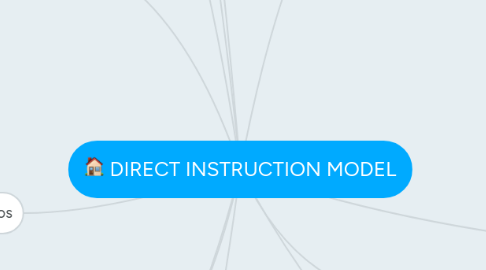
1. When and When Not to Use
1.1. Procedural Knowledge
1.1.1. Concepts (mental constructs)
1.1.1.1. concrete, simple, visible attributes
1.1.1.2. widely recognized / critical attributes
1.2. Introducing new Topics
1.2.1. vocabulary, skills, processes, techniques
1.2.2. generate interest in topic, learning goals
1.2.3. reinforce knowledge and skills
1.2.3.1. reteach
1.2.3.2. review
2. Relate to pre-assessment findings/ build foundation
3. Specific Steps for Direct Instruction
3.1. Introduction
3.1.1. objectives/learning goals
3.1.2. rationale/purpose for learning
3.1.3. Similar to AVID Essential Questions -- helps learners focus on specific expectations
3.2. Presentation
3.2.1. demonstration
3.2.2. think-aloud (explicit mental activity of teacher)
3.2.3. other ways not listed in text could include:
3.2.3.1. Jigsaw groups
3.2.3.2. Expert collaboration
3.2.3.3. Power point or Prezi
3.3. Guided Practice
3.3.1. additional scenario(s)
3.3.2. students work along with teacher
3.3.2.1. can use a document camera for this (ex: Schaeffer color-writing for essays)
3.3.3. think aloud or mnemonic devices
3.3.4. provide corrective feedback
3.3.5. should not be graded; students practice without risk of penalty
3.4. Independent Practice
3.4.1. activities should be similar to the ones practiced with the teacher, initially
3.4.2. eventually support can be withdrawn and activities can become more challenging
3.4.2.1. student progress can inform future lesson design
4. Example Scenarios
4.1. Kindergarten -- jumping jacks
4.2. 6th grade Science, butterfly project
4.3. 9th grade Algebra, math functions; PEMDAS
4.4. various technologies used in all 3
5. Planning for Teaching
5.1. make sure what students are learning (factual, conceptual, procedural) has clearly defined steps or attributes
5.2. have clear goals and expectations
5.2.1. using EQs can help
5.2.2. make sure students know clear objectives
5.3. review knowledge and skills in advance
5.3.1. teacher can find potential areas of concern
5.3.2. teacher can pick the best problems for students to work through in gaining the skill
5.4. select best examples
6. Differentiating Instruction
6.1. creating differentiated experiences or access to the content
6.1.1. students could watch a video after a live presentation if they need more support
6.1.2. flipped instruction?
6.1.3. animated or simulated instruction
6.2. Process
6.2.1. student groupings
6.2.2. choice of practice examples
6.2.3. partner work; peer to peer support
6.2.4. varied graphic organizers
6.3. Product
6.3.1. varied ways of demonstrating mastery
7. Benefits
7.1. critical development of thinking skills
7.2. create confident independent workers
7.3. strengthens autonomous learning
7.4. gain understanding of self
8. Value of Adding Technology
9. Terrence Thatcher
9.1. 3rd grade
9.1.1. new at Lockborne's Elementary
9.2. ELLs focus
9.2.1. "emancipate from poverty" -- technology
9.3. Excited about mind-mapping software
9.3.1. Heidi, technology coach
9.3.2. Suggests direct instruction first
9.3.2.1. start with what you know
9.3.2.2. learn with students on new technology
9.4. at first, thinks direct instruction is outdated
10. Definition and Explanation
10.1. foundational skills
10.1.1. teachers: large impact on students
10.1.2. students:
10.1.2.1. clear goals
10.1.2.2. supportive structure
10.1.2.3. timely feedback
10.2. Teacher directed (expert)
10.2.1. "I do, we do, you do..."
10.2.2. students listen, learn, and practice
10.2.3. "how to..." format
10.3. Specific uses
10.3.1. procedures / procedural knowledge
10.3.2. facts and concepts
10.4. Steps
10.4.1. Introduce new content / concepts
10.4.2. Provides guided and independent practice
10.4.3. Not just lecture

